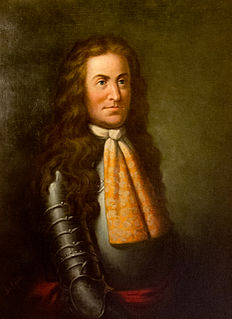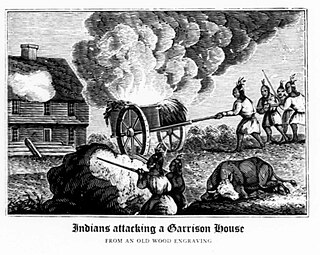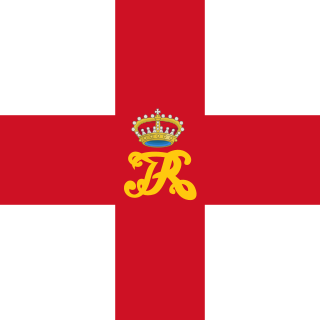
The Thirteen Colonies, also known as the Thirteen British Colonies or the Thirteen American Colonies, were a group of colonies of Great Britain on the Atlantic coast of North America founded in the 17th and 18th centuries which declared independence in 1776 and formed the United States of America. The Thirteen Colonies had very similar political, constitutional, and legal systems, and were dominated by Protestant English-speakers. The New England colonies, as well as the colonies of Maryland and Pennsylvania, were founded primarily for religious beliefs, while the other colonies were founded for business and economic expansion. All thirteen were part of Britain's possessions in the New World, which also included colonies in Canada, Florida, and the Caribbean.
Timeline of the American Revolution — timeline of the political upheaval culminating in the 18th century in which Thirteen Colonies in North America joined together for independence from the British Empire, and after victory in the Revolutionary War combined to form the United States of America. The American Revolution includes political, social, and military aspects. The revolutionary era is generally considered to have begun with the passage of the Stamp Act in 1765 and ended with the ratification of the United States Bill of Rights in 1791. The military phase of the revolution, the American Revolutionary War, lasted from 1775 to 1783.
This section of the timeline of United States history concerns events from before the lead up to the American Revolution.

Sir Edmund Andros was an English colonial administrator in British America. He was the governor of the Dominion of New England during most of its three-year existence. At other times, Andros served as governor of the provinces of New York, East and West Jersey, Virginia, and Maryland.

The colonial history of the United States covers the history of European colonization of America from the early 16th century until the incorporation of the colonies into the United States of America. In the late 16th century, England, France, Castile, and the Dutch Republic launched major colonization programs in America. The death rate was very high among those who arrived first, and some early attempts disappeared altogether, such as the English Lost Colony of Roanoke. Nevertheless, successful colonies were established within several decades.

King Philip's War was an armed conflict in 1675–1678 between indigenous inhabitants of New England and New England colonists and their indigenous allies. The war is named for Metacom, the Wampanoag chief who adopted the name Philip because of the friendly relations between his father Massasoit and the Mayflower Pilgrims. The war continued in the most northern reaches of New England until the signing of the Treaty of Casco Bay in April 1678.

The Province of North Carolina was a British colony that existed in North America from 1712 to 1776, created as a proprietary colony. The power of the British government was vested in a governor of North Carolina, but the colony declared independence from Great Britain in 1776. The Province of North Carolina had four capitals: Bath from 1712 to 1722, then Edenton until 1743, Brunswick until 1770, and New Bern thereafter. The colony later became the states of North Carolina and Tennessee, and parts of the colony combined with other territory to form the states of Georgia, Alabama, and Mississippi.

The Dominion of New England in America (1686–89) was an administrative union of English colonies covering New England and the Mid-Atlantic Colonies. Its political structure represented centralized control similar to the model used by the Spanish monarchy through the Viceroyalty of New Spain. The dominion was unacceptable to most colonists because they deeply resented being stripped of their rights and having their colonial charters revoked. Governor Sir Edmund Andros tried to make legal and structural changes, but most of these were undone and the Dominion was overthrown as soon as word was received that King James II had left the throne in England. One notable change was the introduction of the Church of England into Massachusetts, whose Puritan leaders had previously refused to allow it any sort of foothold.

The Townshend Acts or Townshend Duties, refers to a series of British acts of Parliament passed during 1767 and 1768 relating to the British colonies in America. They are named after Charles Townshend, the Chancellor of the Exchequer who proposed the program. Historians vary slightly as to which acts they include under the heading "Townshend Acts", but five are often listed:

The War of the Regulation, also known as the Regulator movement, was an uprising in British America's Carolina colonies, lasting from around 1765 to 1771, in which citizens took up arms against colonial officials, whom they viewed as corrupt. Though the rebellion did not change the power structure, some historians consider it a catalyst to the American Revolutionary War. Others like John Spencer Bassett take the view that the Regulators did not wish to change the form or principle of their government, but simply wanted to make the colony's political process more equal. They wanted better economic conditions for everyone, instead of a system that heavily benefited the colonial officials and their network of plantation owners mainly near the coast. Bassett interprets the events of the late 1760s in Orange and surrounding counties as "...a peasants' rising, a popular upheaval."

Benjamin Church was an English colonist in North America. He was a military leader of the historic predecessor of the United States Army Rangers, captain of the first Ranger force in America (1675). Church was commissioned by Josiah Winslow, the Governor of the Plymouth Colony, to form the first ranger company for King Philip's War. He later commanded the company to raid Acadia during King William's and Queen Anne's wars in the early 1700s, as French and English hostilities played out in North America. The two powers were competing for control in colonial territories. He was promoted to major and ended his service at the rank of colonel, as noted on his gravestone.

Edward Shippen was the second mayor of Philadelphia, although under William Penn's charter of 1701, he was considered the first.
Herman Husband (1724–1795), also known as Harmon Husband, was a farmer, radical, pamphleteer, author, and preacher. He is best known as a leader of The Regulators, a populist rebellion in the Carolinas in the years leading up to the American Revolutionary War. He was born on December 3, 1724, in Cecil County, Maryland to William Husband and Mary Kinkey/Kankey. He was likely named after his maternal grandfather, Herman Kankey (c.1680-1732). Herman was raised as an Anglican, but became disenchanted with his original faith. One of the many to be inspired to the Great Awakening after hearing George Whitefield preach, he became a "New Light" Presbyterian and then a Quaker. Husband was twice elected to the North Carolina assembly, but was expelled during his second term.

The Great Swamp Fight or the Great Swamp Massacre was a crucial battle fought during King Philip's War between the colonial militia of New England and the Narragansett tribe in December 1675. It was fought near the villages of Kingston and West Kingston in the Colony of Rhode Island and Providence Plantations. The combined force of the New England militia included 150 Pequots, and they inflicted a huge number of Narragansett casualties, including many hundred women and children. The battle has been described as "one of the most brutal and lopsided military encounters in all of New England's history." Since the 1930s, Narragansett and Wampanoag people commemorate the battle annually in a ceremony initiated by Narragansett-Wampanoag scholar Princess Red Wing.
The First Abenaki War was fought along the New England/Acadia border primarily in present-day Maine. Richard Waldron and Charles Frost led the forces in the northern region, while Jean-Vincent d'Abbadie de Saint-Castin worked with the tribes that would make up the Wabanaki Confederacy. The natives engaged in annual campaigns against the English settlements in 1675, 1676 and 1677. Waldron sent forces so far north that he attacked the Mi'kmaq in Acadia.